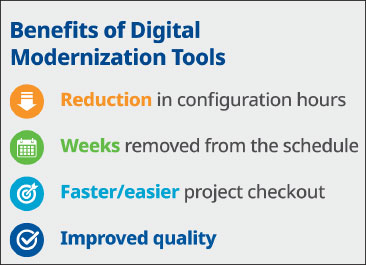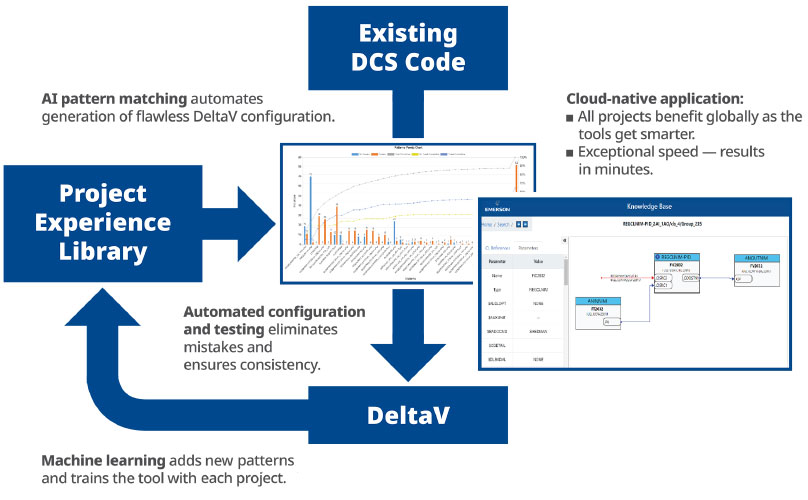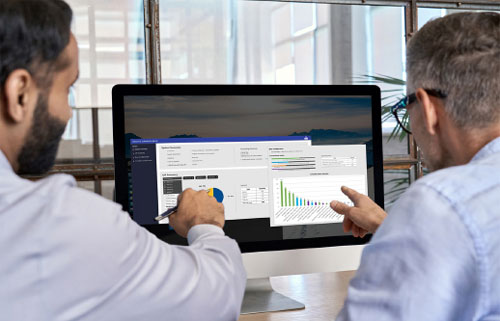- By Aaron Crews
- May 01, 2023
- Manufacturing Digitalization
Summary

AI- and cloud-based engineering tools accelerate control system modernization efforts.
Artificial intelligence (AI) and machine learning (ML) technologies are having a moment right now, and many manufacturers are eager to transform their infrastructure to apply these types of technologies to improve operations. But applying these technologies requires a modern infrastructure, and reaching this goal is fraught with complexities. This begs the question: “Can we apply AI and ML to ease the modernization process itself?”
The answer is yes. End users can apply AI and ML technology to projects to reduce cost, mitigate risks, and accelerate schedules. The result is expedited delivery of modern tools to manufacturing operations, enabling new insights and transformative business practices.
Operational challenges
Today’s process manufacturers face a more complex environment than ever before. Operating in a global marketplace, they are being forced to compete within an everexpanding arena. Staying effective means operating reliably, safely, and efficiently by employing technologies that create more flexible manufacturing environments to deal with changing customer needs, supply chain disruptions, and personnel shortages.
Unfortunately, many of those same manufacturers are still using control technologies that are 20, 30, or even 40 years old. Not only are these legacy systems typically complex and difficult to operate, but they often require specialized expertise and parts to keep them running, leading to extended outages and expensive repairs. Also, these problems will only get worse in the future as automation suppliers discontinue support for legacy systems, and as the few remaining personnel with specialized experience in these systems retire.
The most obvious solution to aging technology in the plant is control system modernization, but modernization projects can seem overwhelming. Plants that have been operating for decades often have many instances of custom automation that are critical to running the plant properly. Without a deep bench of expert personnel, reengineering all that automation to function under a new control system appears to be a daunting task. It creates the fear that a new system might not operate as efficiently or effectively as the old system because something was not converted correctly.
The typical response has been to wait. Process manufacturers want to implement new, modern technologies, but they also need to avoid harming or disrupting the way the plant operates. Project teams often do not have the resources—people, tools, budgets, and insights—to redo their automation from scratch, but they also do not want to invest in an upgrade that does the same thing they were already doing. Ultimately, they feel stuck. But that paradigm is changing.
Benefits of modern control

Highly efficient and competitive modern process control plants look very different from plants of just 10 years ago. Helpful process technologies that were unavailable or very expensive many years ago are considered best practices today. Some are critical to meeting regulations, while others keep a plant operating at peak efficiency. One example is pervasive sensing technologies.
The cost of sensors has fallen dramatically in recent years, just as experienced personnel—those who can look at an asset and quickly identify problems—are leaving the workforce in droves. As a result, plants are adding sensors to many more assets to increase performance and safety visibility, helping operators do their jobs better through automated decision support. Today’s sensors provide easy-to-understand data, comprehensible by even the least experienced operators. The best automation suppliers have made it intuitive to integrate that data into the control system, helping foster better awareness and control.
Many plants are also using advanced industrial software to manage alarms, both to automatically reduce alarm floods and to improve safety when executing abnormal process steps, such as startup and shutdown, or firing of burners. Alarm applications are designed to integrate with modern control systems to improve visibility and simplify customization of alarm content based on process state. These technologies can also be coupled with advanced process control, which enables plants to build best-practice control strategies into automation to ensure that they are repeated the same way every time.
Project design and engineering challenges
Plants operating legacy control systems are typically unable to take advantage of these and other modern technologies—unless money is spent to construct complex, fragile custom engineering to connect the systems. Such solutions typically increase the cost of support and the need for expert personnel, who are already difficult to find. The better solution is to modernize the plant, implementing a new control system built from the ground up to support today’s essential automation features. But traditional methods face many hurdles.
The first hurdle to modernization is managing the project design and engineering. Upwards of 50 percent of any modernization project is engineering work, and that work traditionally requires many experienced personnel and many hours of time-consuming design, checks, and rechecks.
When engineers develop and use tools for modernization projects, those tools are typically project-based and not reused. Every project is a little different from the one that preceded it, and it is designed around the knowledge of the engineer who programmed the tools—a person who may no longer be available. That means each project is typically self-contained; it is planned, designed, and documented from the ground up.
The engineering company involved typically uses a tool to pull the data from the legacy control system into a database. Each engineer has a tool they like, and each tool has its own pros and cons, and associated bugs.
After the legacy data is moved, engineers go through the database and manually assign every function block and piece of code to a template, and they then develop custom queries around those templates. Again, the process is manual. After the templating step, engineers create new tables and design append queries to translate the legacy code to the code for the new control system, then use the text files generated from that process to develop a format specification file that is used to create new code.
In this traditional manner, each stage of the engineering process is manual. Not only is this manual work time-consuming, but there are numerous opportunities for mistakes everywhere along the path. This leaves project teams with two choices, neither of them ideal. They can either spend a lot of time double-checking the process and fixing errors as they come up, or they can leave the debugging until the end of the process when it is on the critical path and fix them then. In either case, the time spent double- and triple-checking, and then fixing mistakes is zero value-add.
Also, in many cases, this process is performed via email, with days or weeks of waiting between each step. When mistakes are discovered, those mistakes not only add to the time needed to fix the problems, but also add more waiting time as engineers transfer data back and forth.
The engineering stage is complex, and traditional modernization strategies are challenging. So, with limited budgets and personnel, many project teams opt for “replacement in kind”—the most low-risk option for modernization. But this often leaves the operations team with an automation system lacking the performance improvements available with modern technology and can limit the team’s ability to take advantage of those technologies in the future.
Digital technologies for project engineering
The way to reduce the risk associated with modernization projects is to shift away from traditional project engineering and instead embrace modern solutions based in digital technologies. Today’s automation providers are creating tools to digitalize the project engineering stage of modernization.
Digital tools dramatically reduce the time spent engineering while simultaneously eliminating much of the potential for errors an enabling best practices to drive improved plant performance. Now, instead of simple conversion tools to update controls, teams are looking to comprehensive smart tools to identify functions and automatically replace them with modern implementations in a new system.
The top automation providers in the world execute multiple modernization projects every day. Their engineering teams then process the data from each of those hundreds of annual modernization projects in a central, cloud-native toolset. Using AI to automatically leverage the organization’s past project experience, engineers structure the data and separate it into its core functions while identifying complex control strategies and areas for improvement. That means, instead of using a conversion tool that has been used on one or two projects, today’s end user project teams can work with their automation provider to train centralized machine learning tools with data from hundreds or thousands of projects.
The AI digs through the legacy code and identifies functions that are part of the tool’s past project experience. If the AI sees something repeated that matches work performed on previous projects, it extracts that code and structures it to transfer over to the new control system. Not only is the code automatically converted, but it uses a bestpractice structure for the new control system that is automatically documented to create a powerful automation foundation. Because the process is automated, the project team does not need to worry about errors in the code (Figure 2).

In some cases, the AI will find code or other content that isn’t recognized. In these instances, the tool not only automatically generates logic drawings, but also uses an ML algorithm to identify clusters of repeated control strategies as candidates to add to the library. When the tool has enough instances of that code, engineers can review and promote those strategies to the library. As a result, the tool continues to get smarter with each project, continually adding new designs and best practices.
This process ensures that every modernization is the best modernization because the tools are continually improved over an ever-growing number of projects. And, because those tools are cloud-native, they are constantly updated, ensuring that teams are always engineering their projects with the highest possible accuracy and efficiency.
Better mapping with metrics

These metrics not only help the team budget and slice the project into reasonable phases but also help remove late-stage surprises and change orders. Traditionally, teams made a lot of assumptions about each project in the design phase, but when they were wrong, the automation engineering partner would need to issue change orders. This led to some teams carrying too much contingency in the budget, and others not carrying enough. With the metrics available in digital toolsets, however, teams have a much better idea of what needs to be done from the very beginning of project execution, dramatically reducing costly changes, and the need to carry budget overages to plan for them.
Faster and foundational
Digital modernization toolsets are also faster than the traditional conversion tools of the past. Instead of emailing files back and forth, teams simply upload data into native cloud tools to take advantage of the increased processing power in the cloud. Results typically come in minutes rather than days. This fast turnaround helps teams ensure that they can get their basic automation foundation—built on engineering strategies that have been validated by world experts and used many times—completed early on in a modernization project.
Even more important, that foundation is built with more complex automation in mind. The new automation is not just a conversion of what the plant had before. Instead, the team receives a functional reimplementation of control logic in the new control system that also contains all the hooks needed to add on such advanced functionality as state-based control, advanced control, dynamic alarming, and optimization for abnormal operations— switching grades or startup and shutdown, for example. Teams no longer have to extensively reengineer to implement available new technologies when upgrading a control system.
As more teams use advanced modernization tools to drive better projects, they will also leverage the ability to store all the content from digital tools in a single cloud location. Project engineering teams at engineering companies and integrators will be able to collaborate with the automation vendor to take advantage of this experience, gain access to these tools, and access a central location to manage project libraries.
All information, such as engineering designs, documentation, and support, will be accessible via the cloud through a continuously updated digital platform. This complete repository will provide information that both engineering teams and their customers can use across the lifecycle of the modernized facility.
Easier, more accurate modernization
Today’s advanced cloud-based modernization tools drive increased value compared to traditional conversion tools. Not only do they dramatically speed the process of engineering a modernization project, but they do it with more visibility across the entire project while simultaneously eliminating errors. Teams spend less time testing project engineering steps and are not crunched for time at the end of the project the way they typically were in the past. Automating these tasks removes countless hours of work and sets teams up to implement more complex automation strategies much earlier in the project, helping to ensure that they more easily accomplish the goals that put them on the path to modernization in the first place.
All figures courtesy of Emerson
Reader Feedback
We want to hear from you! Please send us your comments and questions about this topic to InTechmagazine@isa.org.


